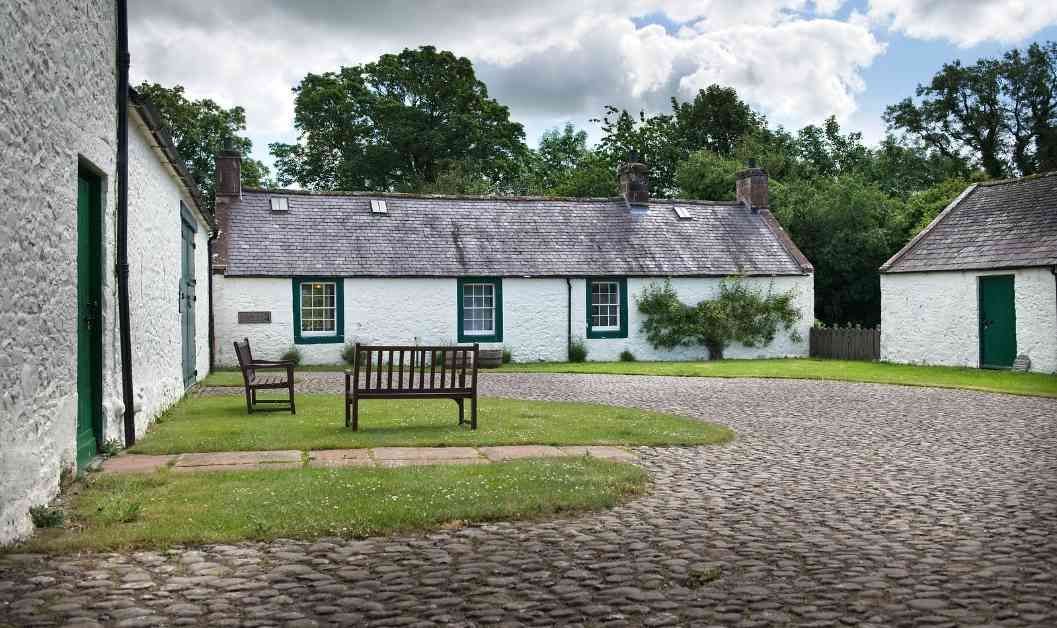Exploring the Rich History of Robert Burns’ Ellisland Farm
Nestled on the picturesque banks of the River Nith in Dumfries and Galloway lies Ellisland Farm, a historic site with a fascinating past. This 170-acre property was once home to the renowned Scottish poet Robert Burns, where he penned some of his most famous works, such as “Auld Lang Syne” and “Tam O’Shanter.” Beyond being a creative sanctuary for Burns, Ellisland Farm also holds a treasure trove of stories about the diverse individuals who lived and worked on the land throughout the years.
Uncovering the Untold Stories
A new exhibition at Ellisland Farm, titled “Beyond Burns: Ellisland’s People,” delves into the lives of soldiers, doctors, dairymaids, and thieves who crossed paths with the farm. This showcase of history brings to light previously unknown tales, shedding light on the experiences of those who called Ellisland home. From the trials and tribulations of a teenage servant jailed for theft to the resilience of a ploughman who survived the Crimean War, each story adds depth to the farm’s rich tapestry of history.
One of the most striking revelations in the exhibition is the documentation of local tenant farming families who continued to work the land long after Burns’ departure in 1791. These families toiled on the fields, carrying on the legacy of agricultural labor at Ellisland. Through archival images, oral histories, and personal accounts, visitors can immerse themselves in the everyday lives of these hardworking individuals who played a vital role in shaping the farm’s identity.
Preserving Heritage Through Innovation
The “Burns, Barns & Byres” project, which encompasses the exhibition at Ellisland Farm, aims to not only unearth forgotten stories but also preserve the site’s historical artifacts for future generations. With support from organizations like Historic Environment Scotland, Museums Galleries Scotland, and the Holywood Trust, the project has been able to fund initiatives that safeguard the cultural heritage of Ellisland. From acquiring equipment to protect valuable artifacts to hosting community and education events, the project is a testament to the commitment to preserving Scotland’s rich history.
Joan McAlpine, Project Director of the Robert Burns Ellisland Trust, expressed the significance of the exhibition in engaging new audiences and connecting local communities to their heritage. Through collaborative efforts with volunteers and young people, the exhibition aims to bridge the gap between past and present, fostering a deeper appreciation for the stories that define Ellisland Farm.
Adam Dickson, Museum Project Officer, emphasized the importance of shedding light on the lives of everyday people who contributed to the farm’s legacy. By highlighting the stories of laborers, servants, and tenants, the exhibition honors the collective history of Ellisland, showcasing the resilience and camaraderie that defined life on the farm.
Embracing Tradition and Innovation
The exhibition at Ellisland Farm not only celebrates the past but also looks towards the future. By incorporating elements of modern technology, such as archive film and interactive displays, the exhibition offers visitors a dynamic and immersive experience. From the sights and sounds of the 1950s farm life to the personal narratives of those who lived and worked at Ellisland, the exhibition is a blend of tradition and innovation, inviting audiences to engage with history in new and exciting ways.
Dr. Susan O’Connor, Head of Grants at HES, highlighted the importance of preserving intangible cultural heritage and connecting past traditions with contemporary audiences. Through initiatives like the “Burns, Barns & Byres” project, Ellisland Farm is not only preserving its historical significance but also fostering a sense of continuity between generations, ensuring that the stories of the past remain relevant and impactful in the present.
Lucy Casot, CEO of Museums Galleries Scotland, echoed the sentiment of celebrating traditions and sharing new stories to strengthen the bond between Ellisland Farm and its community. By engaging with local residents and visitors alike, the exhibition at Ellisland serves as a bridge between the past and the present, fostering a sense of connection and shared heritage among all who experience it.
Karen Ward Boyd, Director of the Holywood Trust, emphasized the importance of storytelling in preserving social and cultural history. By uncovering the stories of those connected to Ellisland over the years, the exhibition serves as a valuable resource for understanding the diverse experiences that have shaped the farm’s identity. Through initiatives like this, Ellisland is not only preserving its past but also opening up new opportunities for community engagement and knowledge sharing.
As the exhibition opens its doors to the public during Doors Open in September, visitors will have the opportunity to immerse themselves in the rich history of Ellisland Farm. From the captivating stories of soldiers and thieves to the enduring legacy of tenant farming families, the exhibition offers a glimpse into the lives of those who lived and worked on the land. By exploring the untold stories of Ellisland’s people, visitors can gain a deeper appreciation for the farm’s significance in Scottish history and culture.
In conclusion, the exhibition at Ellisland Farm serves as a testament to the enduring legacy of Robert Burns and the countless individuals who contributed to the farm’s vibrant history. Through a blend of tradition and innovation, the exhibition offers a multifaceted exploration of the lives and experiences of those connected to Ellisland. By preserving these stories and sharing them with the public, Ellisland Farm continues to be a beacon of cultural heritage, inviting visitors to connect with the past and celebrate the diverse narratives that define this historic site.
































